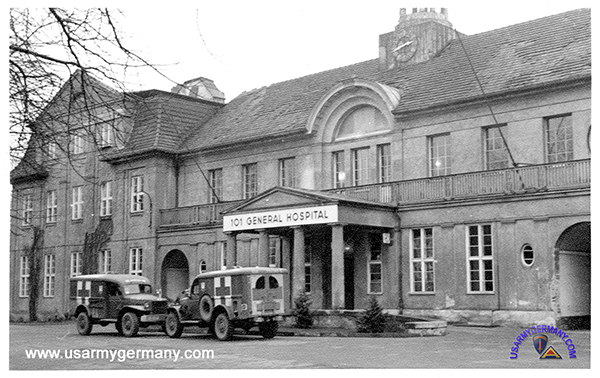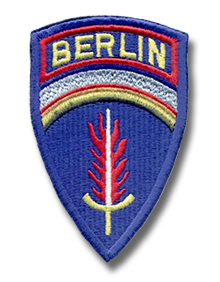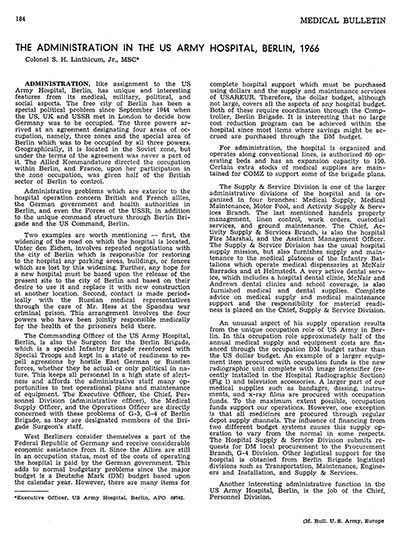| If you do
NOT see the Table of Contents frame to the left of this page, then
Click here to open 'USArmyGermany' frameset |
|||
|
Berlin Army Hospital |
|||
|
|
|||
|
|||
|
|
|||
| Berlin Army Hospital (and other Medical Units) | |||
|
US Army Hospital Berlin |
|||
| 101st General Hospital | |||
 Entrance to the 101st General Hospital, Rudower Straße 56, Berlin-Neukölln, 1945 |
|||
 pre-WWII postcard 600.jpg) The Neuköllner Krakenhaus, requisitioned by the US Army in 1945 and operated as the 101st General Hospital. Postcard shows the entire plant. (Webmaster collection) |
|||
| 1945 | |||
| (Source: WWII US Medical Research Centre, Link) | |||
| The 101st General Hospital arrived in Helmstedt, Germany on 9 July 1945. It was announced that the rail convoy could continue no further, and so all personnel detrained and were then driven to the tented Helmstedt Staging Area, where they took some much needed rest after the lengthy train trip. After an advance party had preceded it, the balance of the unit then travelled via motor convoy to Wannsee, Germany, arriving on 13 July 1945. This small Berlin suburb was the unit’s first sight of the battered and smashed capital, and all of the personnel took the opportunity to explore much of the city; the famous Tiergarten “Black Market”, Potsdamer Platz, Unter den Linden, Reich Chancellery, the gutted Reichstag, Berlin Tempelhof Airport and much more. Since the 101st had arrived into Germany several months after V-E Day, many of its personnel were sent on temporary or special duty to Dispensaries, to the site of the “Big Three” conference (Potsdam Conference between Soviet leader Joseph Stalin, British Prime Minister Winston Churchill (replaced on July 26 by Prime Minister Clement Attlee), and U.S. President Harry Truman; held in Potsdam from 17 July 1945 – 2 August 1945 –ed), or to the 113th Evacuation Hospital which was already established in the vicinity. This new status lasted only one week, for a new site, more adaptable for a General Hospital had been located and the 101st once again packed up and hiked to Neukölln, a locality on the opposite side of Berlin. It was with regret that the personnel left the homes, apartments and the luxury with which they were just beginning to believe was true, and started moving. Because the Hospital continued to operate while moving, it took a week to transplant all of the personnel, equipment, patients, etc. and set same up in the new site. Then followed more work to open up, repair and build more departments and sections. The first trickle of staff members departing for the States began in early August, and more changes became effected in personnel. By the middle of September 1945, the 101st was the only General Hospital in operation in the Berlin District, American Zone, operating out of the Zinnowwald Schule (Zehlendorf), a former public school on the outskirts of Berlin. It was here that the organization opened its 450-bed medical facility, which would operate from 25 August 1945 to 17 September 1945. Orders applying to the 101st General Hospital were issued with Circular No. 82, dated 18 September 1945, U.S. Headquarters Berlin District and Headquarters First Airborne Army, Berlin, Germany, APO # 755. It was further indicated that the 101st was to open Hospital Plant # 4468, at 0001, 18 September 1945, in Krankenhaus Buckow (Buckow) (a.k.a. Neuköllner Krankenhaus). During the above period, the hospitalization policy for Army Hospitals within the Berlin District was 10 days for the 279th Station Hospital and 120 days for the 101st General Hospital for conditions other than VD. Instructions from the Surgeon, Berlin District, stipulated that patients examined at Dispensaries and whose diagnosis indicated that they could be returned to duty within ten days were to be transferred to the 279th Sta Hosp (operating Hospital Plant # 4464, at the Stubenrauch Krankenhaus) for necessary medical care. Those cases examined at Dispensaries and whose diagnoses indicated that they would require over ten days hospitalization were to be transferred to the 101st Gen Hosp for further medical care. |
|||
|
|
|||
| 279th Station Hospital | |||
 700.jpg) Entrance to the 101st General Hospital, Rudower Straße 56, Berlin-Neukölln, 1945 |
|||

